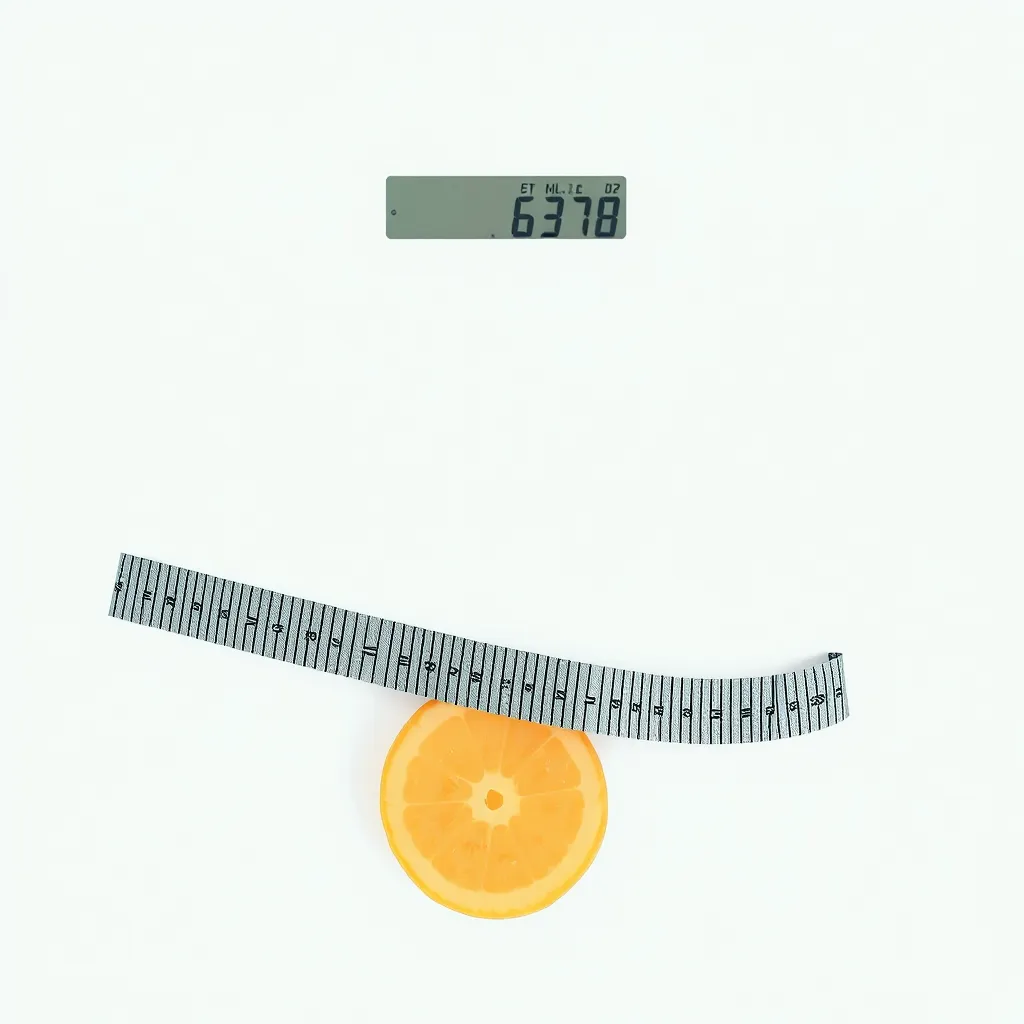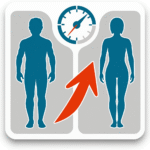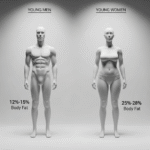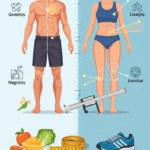Body Fat Percentage Calculator: Evaluate Your Levels! Discover how to measure body fat, assess health risks, and reach your fitness goals today.
Body Fat Percentage Calculator
Calculate your body fat percentage using the U.S. Navy measurement method
Your Results
Male Categories
- Essential: 2-5%
- Athletes: 6-13%
- Fitness: 14-17%
- Average: 18-24%
- Obese: 25%+
Female Categories
- Essential: 10-13%
- Athletes: 14-20%
- Fitness: 21-24%
- Average: 25-31%
- Obese: 32%+
Table of Contents
Body fat percentage is a vital measure for understanding health and fitness. Unlike weight, it reveals the proportion of body fat, which is crucial for assessing health risks like obesity and diabetes. This comprehensive guide explains the U.S Navy's method for calculating body fat and the importance of monitoring it for fitness goals. Learn how to take accurate measurements interpret results, and understand gender differences in body fat targets. Regular tracking and consultation with healthcare professionals can enhance your wellness journey, promoting healthy lifestyle choices and effective weight management
Introduction to Body Fat Percentage
Body fat percentage is a crucial metric in the realm of health and fitness, providing a more comprehensive overview of an individual's body composition than traditional weight measurements alone. Unlike weight, which does not differentiate between fat mass and lean mass, body fat percentage quantifies the proportion of fat in relation to total body weight. This distinction makes it a significantly more informative indicator of health, as it helps assess the risks associated with excess fat, especially in critical areas such as visceral fat around the organs.
Understanding body fat percentage is essential for numerous reasons. First, it aids in identifying potential health risks. Research indicates that higher body fat percentages are linked to various health issues, including obesity, diabetes, cardiovascular diseases, and certain types of cancer. Monitoring body fat percentage allows individuals to gain insight into their health status and assists healthcare professionals in tailoring personalized health plans. Moreover, for athletes and fitness enthusiasts, tracking body fat percentage can offer a clearer perspective on performance goals and body composition changes that weight alone cannot provide.
Furthermore, many individuals seek to calculate their body fat percentage as part of their fitness journeys. Whether aiming for weight loss, muscle gain, or overall well-being, understanding body fat can help in setting realistic and achievable goals. It allows for better management of diet and exercise routines, leading to optimized results. In conclusion, body fat percentage is a vital element in assessing health and fitness, surpassing traditional weight metrics in its ability to indicate overall body composition and health risks.
The U.S. Navy Measurement Method
The U.S. Navy measurement method is a widely recognized approach for calculating body fat percentage, leveraging simple measurements that can be easily taken. This method requires specific measurements including height, neck circumference, waist circumference, and for women, hip circumference. The process begins with gathering the required data points, which can be performed with a flexible measuring tape for accuracy.
Firstly, the individual must have their height measured in feet and inches. It is important to stand straight against a wall to ensure a precise measurement. Next, the neck circumference needs to be measured, typically at the narrowest point of the neck. This measurement helps in determining the overall body fat in relation to muscularity and fat distribution.
For waist circumference, the tape measure should be placed around the natural waistline, which is often just above the belly button. This measurement is crucial, as it directly correlates with fat around the abdomen, an important factor in health assessments. In the case of women, an additional measurement of hip circumference is necessary; this is obtained by measuring the widest part of the hips. Both of these measurements combined provide a more comprehensive view of body fat distribution.
After collecting these measurements, the U.S. Navy method utilizes specific formulas to calculate body fat percentage. For men and women, the equations differ slightly due to physiological differences in body composition. It is recommended to input these measurements into a calculator or spreadsheet designed specifically for this methodology, ensuring accuracy and ease of use. This systematic approach facilitates an understanding of body composition, offering a practical means to monitor health and fitness progress.
Gathering the Required Measurements
Accurately calculating body fat percentage necessitates precise measurements of specific body parts. The fundamental measurements required for this assessment include height, neck circumference, waist circumference, and hip circumference. Each of these dimensions plays a crucial role in determining overall body composition and, more specifically, body fat percentage. Below are guidelines to ensure that you gather these measurements accurately.
To begin with, measuring height is straightforward. Stand straight against a wall without shoes, ensuring your heels, buttocks, and shoulders touch the wall. Use a flat object like a ruler or a book to level with the top of your head, and mark the point on the wall for measurement. Subsequently, use a tape measure to determine the distance from the floor to the mark.
Next is neck circumference. Place the measuring tape around the neck, just below the larynx, and ensure that it sits comfortably on the skin without being too tight or loose. A common mistake is to measure over clothing, which can lead to inaccuracies, so it is advisable to take this measurement directly on bare skin.
Moving on to waist circumference, find the midpoint between the bottom of the rib cage and the top of the hip bone. Wrap the tape measure around the waist at this point, ensuring it remains parallel to the floor. Remember not to suck in your stomach during this measurement, as it can lead to an underestimation of your waist size.
Finally, hip circumference is measured at the widest part of the hips, which is typically around the top of the buttocks. This measurement is also taken with the tape measure parallel to the floor. Avoid common errors such as measuring too high or too low, as this can significantly impact the accuracy of the body fat percentage calculation.
Using the Calculator: Step-by-Step
Calculating body fat percentage can be efficiently achieved through the use of an online body fat percentage calculator. This tool simplifies the process and provides quick results. Below is a comprehensive step-by-step guide to walk you through using the calculator effectively.
First, you need to find a reliable online body fat percentage calculator. Many reputable health and fitness websites host these calculators, so visit a site that you trust. Once located, navigate to the body fat percentage section to proceed.
Next, you will be prompted to enter specific measurements. Typically, the calculator will ask you for your height, weight, age, and sex, as these variables are essential for a precise calculation. Some calculators may require additional metrics such as waist, hip, and neck circumference. Ensure that the measurements are accurate to obtain valid results.
After inputting your data, carefully review the measurements before submitting them. Accuracy is crucial since small errors can significantly impact the final calculation of your body fat percentage. Once you have verified the information, click the calculate button.
The results will be displayed on the page following your submission. Most calculators will present your body fat percentage along with a brief analysis or interpretation of the figure. This analysis generally categorizes your body fat percentage into ranges, indicating whether it falls within a healthy, overweight, or obese classification.
Lastly, it is important to understand that while online body fat percentage calculators provide a convenient way to estimate body fat, they may not always be precise. Various factors, such as hydration levels and muscle mass, can affect the outcome. Therefore, consider using the results as a guideline rather than an absolute measure of your body composition.

Interpreting Your Body Fat Percentage Results
Understanding body fat percentage is crucial for assessing overall health and fitness. Body fat percentage can be categorized into distinct groups that provide insights into one’s physical condition. The five primary categories are essential fat, athletic, fitness, average, and obese, with variations based on gender.
Essential fat is necessary for basic physiological functions. For males, this percentage typically ranges from 2% to 5%, while for females, it ranges from 10% to 13%. Maintaining this level is vital for reproductive health and other bodily functions. When body fat levels fall below these thresholds, serious health risks can arise.
Athletic individuals usually have a body fat percentage that falls between 6% and 13% for men and 14% to 20% for women. This range is often seen in competitive athletes who require lower body fat levels to optimize performance. Though beneficial for athletic performance, it is essential for individuals within this category to ensure adequate energy levels to avoid detrimental effects on health.
The fitness category ranges from 14% to 17% for men and 21% to 24% for women. This range typically signifies a well-maintained body; individuals may not be professional athletes but still lead an active lifestyle that contributes positively to their health. Achieving and maintaining this percentage can enhance cardiovascular health and overall physical fitness.
The average body fat percentage is usually between 18% to 24% for men and 25% to 31% for women. While this category is often deemed acceptable, it may indicate an increased risk for weight-related health issues, emphasizing the need for regular monitoring and lifestyle adjustments.
Lastly, values surpassing these averages, classified as obese, trigger heightened health concerns. For men, body fat percentages exceeding 25% and for women, over 32%, can pose significant health risks, necessitating intervention. Tracking body fat percentage is an essential component of health management, helping individuals make informed lifestyle choices that promote overall well-being.
Gender Differences in Body Fat Percentage Goals
Body fat percentage is a critical metric for assessing overall health and fitness. However, there are significant gender differences in the ideal body fat percentage goals that should be recognized. Generally, males tend to have lower body fat percentage recommendations compared to females due to physiological and hormonal differences. For instance, healthy body fat percentage ranges for adult males typically fall between 10% and 20%, while for adult females, the range is generally between 20% and 30%.
The divergence in these figures can be attributed to various factors including hormonal influences and biological functions. Testosterone in males contributes to greater muscle mass and a leaner body composition. This biological makeup allows for a lower body fat percentage to be considered healthy. In contrast, estrogen in females plays a crucial role in reproductive health and fat storage, particularly around the hips and thighs, which contributes to the higher body fat percentage recommended for women.
Additionally, the distribution of fat also varies between genders. Males tend to store fat predominantly in the abdominal area, whereas females typically store fat subcutaneously, meaning just under the skin, in areas like the hips and buttocks. This difference not only influences body fat percentage targets but also impacts health risks related to obesity and fat distribution. High abdominal fat can be linked to various cardiovascular diseases in men, whereas women may face different health concerns linked to fat distribution and overall body composition.
In essence, understanding these gender differences in body fat percentage goals is essential for anyone seeking to monitor their health accurately. Tailoring fitness and nutritional plans to achieve these appropriate body fat percentage targets can enhance one’s overall wellness and fitness journey.
Importance of Body Fat Percentage Monitoring
Monitoring body fat percentage plays a crucial role in achieving and maintaining overall health and fitness. Unlike simply tracking weight, body fat percentage provides a more accurate picture of an individual's body composition. This distinction is essential because weight alone does not differentiate between fat, muscle, and water. By focusing on body fat, individuals can better understand their progress towards fitness goals, which may include fat loss, muscle gain, or improving athletic performance.
Regularly assessing body fat percentage encourages individuals to adopt healthier lifestyle choices. For those looking to lose weight, monitoring body composition can help set realistic and achievable goals. It allows individuals to track changes in body fat while ensuring they are not losing muscle mass in the process. This balance is critical because retaining muscle contributes to higher metabolic rates, thereby facilitating effective weight management. On the other hand, individuals aiming to build muscle can benefit from tracking their body fat percentage to ensure that their training regimens and diet are conducive to muscle growth without accumulating excess fat.
Furthermore, tracking body fat percentage promotes accountability and motivation. By observing how body fat changes in response to specific dietary and exercise programs, individuals are more likely to stay committed to their health plans. As a result, monitoring body fat can act as a feedback mechanism, helping individuals understand what works for their unique bodies while also promoting long-term lifestyle changes. Overall, incorporating body fat percentage measurements into fitness and wellness journeys is integral to achieving sustainable health outcomes.

Limitations of Body Fat Calculators
Body fat calculators have gained popularity as tools for estimating an individual's body fat percentage. However, it is essential to recognize the inherent limitations of these calculators. While they can offer a convenient means of estimating body fat, the calculations are primarily based on generalized formulas that may not adequately account for individual physiological variances.
One significant limitation is that body fat calculators often rely on factors such as height, weight, age, and gender. These variables, when input into the formulas, yield a rough estimate of body fat percentage. However, these calculators fail to consider the distribution of muscle mass in the body. Individuals with higher muscle mass may receive a misleading body fat percentage estimate, as muscle weighs more than fat. Consequently, a person who is very muscular may be categorized as having a higher body fat percentage than is accurate.
Furthermore, different calculators employ various equations derived from diverse populations, which might not be universally applicable. For instance, a formula developed based on a specific demographic group may produce less accurate results for individuals outside that group. In addition, external factors such as hydration levels can significantly impact the readings of body fat scales, leading to fluctuations that are not indicative of a person's true body composition.
Moreover, body fat calculators are generally limited in their ability to distinguish between visceral fat and subcutaneous fat. Visceral fat, which surrounds internal organs, poses a greater health risk compared to subcutaneous fat that lies just under the skin. Therefore, relying solely on a body fat calculator may result in an incomplete understanding of an individual’s health status.
In consideration of these limitations, while body fat calculators can serve as useful tools for tracking general trends, they should not be considered definitive measures of body composition. More comprehensive assessments, such as Dual-Energy X-ray Absorptiometry (DEXA) scans or professional evaluations, may provide a clearer picture of one's health and fitness. A multifaceted approach to understanding body fat is often warranted for a more accurate assessment.
Consulting a Healthcare Professional
Understanding body fat percentage is a crucial aspect of maintaining overall health and wellness. While numerous resources and tools are available for individuals aiming to assess their body fat percentage, it is essential to remember that personal health cannot be effectively navigated without professional insight. Consulting a healthcare professional is highly recommended, particularly when considering significant lifestyle changes based on body fat measurements.
A healthcare provider can provide personalized advice tailored to an individual's unique circumstances, including their age, gender, activity level, and medical history. They can help interpret body fat percentage results within the broader context of overall health, considering factors like muscle mass, weight distribution, and metabolic health. This guidance is invaluable for creating a balanced approach to health improvement, as body fat percentages can significantly vary based on individual body types and health conditions.
Moreover, healthcare professionals can offer comprehensive assessments that may include advanced screening techniques or laboratory tests that go beyond simple body fat measurements. They may also address potential underlying health issues that influence body composition and recommend appropriate interventions, whether dietary changes, exercise regimens, or other lifestyle modifications. Such a multidisciplinary approach maximizes the effectiveness of any health-related goals that revolve around body fat management.
In summary, while it is beneficial to familiarize oneself with the methods of calculating and interpreting body fat percentage, the importance of seeking expert advice cannot be overstated. Engaging with a healthcare professional can provide the necessary framework and support to ensure that any adjustments made to improve body composition are safe, effective, and conducive to long-term health. By working closely with healthcare providers, individuals can achieve a more comprehensive understanding of their body fat percentage and its implications for overall well-being.









